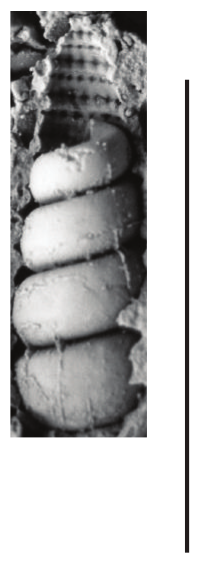| Potamides archiaci Temporal range: Middle Eocene PreꞒ Ꞓ O S D C P T J K Pg N | |
|---|---|

| |
| Abapertural view of holotype Potamides archiaci. Scale bar is 10 mm. | |
| Scientific classification | |
| Kingdom: | Animalia |
| Phylum: | Mollusca |
| Class: | Gastropoda |
| (unranked): | clade Caenogastropoda clade Sorbeoconcha |
| Superfamily: | Cerithioidea |
| Family: | Potamididae |
| Genus: | † Potamides |
| Species: | † P. archiaci |
| Binomial name | |
| † Potamides archiaci Halder & Sinha, 2014 | |
† Potamides archiaci is an extinct species of sea snail, marine gastropod molluscs in the family Potamididae.
The specific name archiaci is in honour of French paleontologist Adolphe d'Archiac, who was one of the pioneering researchers to describe molluscs from the Indian subcontinent. Type specimen are deposited in the Department of Geology, Presidency University, Kolkata.
Distribution

This species occurred in the lower Middle Eocene of Kutch District, Gujarat, western India. The type locality is about 2 km north of village Harudi 23°32′00″N 68°40′52″E / 23.53333°N 68.68111°E / 23.53333; 68.68111, Harudi Formation, lower Middle Eocene.
Description
Potamides archiaci is placed to the genus Potamides according to its shape, coiling pattern, and typical ornamentation.
The shell is small, narrow, turreted and conical. The spire is high. The shell is widening slowly and the apical angle is small. The shell has about 15 depressed whorls, which are separated by prominently impressed sutures. The base of the shell is flat, and the aperture is elliptical. There are two prominent rows of spiral tubercles on the sculpture. The surface in the earliest whorls is marked only by a beaded angularity. Its posterior beads become stronger tubercles, and are more distantly spaced than the anterior beads.
The width of the holotype is 5.9 mm, and its reconstructed height is about 24 mm. The maximum measured width of the shell is 8.05 mm, and its maximum reconstructed height is 31.22 mm.
References
This article include CC-BY-3.0 text from the reference
- ^ Halder, K., & Sinha, P. (2014). "Some Eocene Cerithioids (Gastropoda, Mollusca) from Kutch, Western India, and Their Bearing on Palaeobiogeography of the Indian Subcontinent". Paleontology Journal, 2014, Article ID 673469, doi:10.1155/2014/673469.
| Taxon identifiers | |
|---|---|
| Potamides archiaci | |




